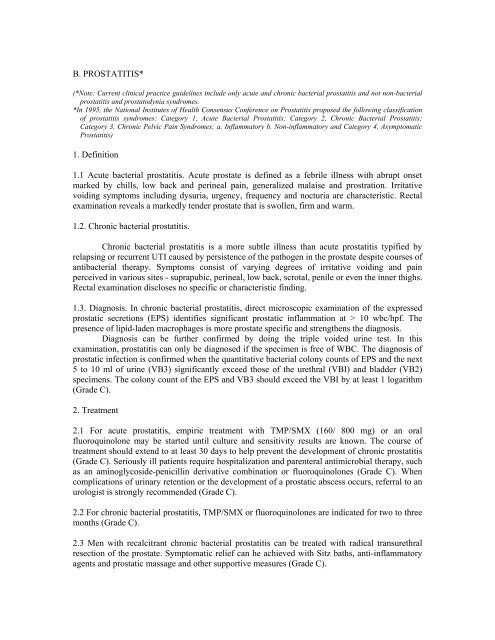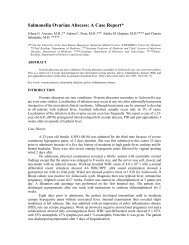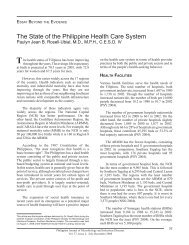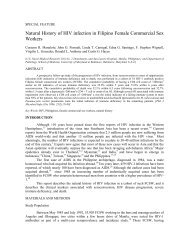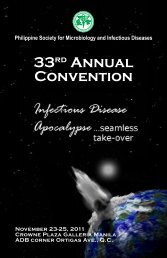The Philippine Clinical Practice Guideline on the Diagnosis and ...
The Philippine Clinical Practice Guideline on the Diagnosis and ...
The Philippine Clinical Practice Guideline on the Diagnosis and ...
You also want an ePaper? Increase the reach of your titles
YUMPU automatically turns print PDFs into web optimized ePapers that Google loves.
B. PROSTATITIS*<br />
(*Note: Current clinical practice guidelines include <strong>on</strong>ly acute <strong>and</strong> chr<strong>on</strong>ic bacterial prostatitis <strong>and</strong> not n<strong>on</strong>-bacterial<br />
prostatitis <strong>and</strong> prostatodynia syndromes.<br />
*In 1995, <strong>the</strong> Nati<strong>on</strong>al Institutes of Health C<strong>on</strong>sensus C<strong>on</strong>ference <strong>on</strong> Prostatitis proposed <strong>the</strong> following classificati<strong>on</strong><br />
of prostatitis syndromes: Category 1, Acute Bacterial Prostatitis; Category 2, Chr<strong>on</strong>ic Bacterial Prostatitis;<br />
Category 3, Chr<strong>on</strong>ic Pelvic Pain Syndromes; a. Inflammatory b. N<strong>on</strong>-inflammatory <strong>and</strong> Category 4, Asymptomatic<br />
Prostatitis)<br />
1. Definiti<strong>on</strong><br />
1.1 Acute bacterial prostatitis. Acute prostate is defined as a febrile illness with abrupt <strong>on</strong>set<br />
marked by chills, low back <strong>and</strong> perineal pain, generalized malaise <strong>and</strong> prostrati<strong>on</strong>. Irritative<br />
voiding symptoms including dysuria, urgency, frequency <strong>and</strong> nocturia are characteristic. Rectal<br />
examinati<strong>on</strong> reveals a markedly tender prostate that is swollen, firm <strong>and</strong> warm.<br />
1.2. Chr<strong>on</strong>ic bacterial prostatitis.<br />
Chr<strong>on</strong>ic bacterial prostatitis is a more subtle illness than acute prostatitis typified by<br />
relapsing or recurrent UTI caused by persistence of <strong>the</strong> pathogen in <strong>the</strong> prostate despite courses of<br />
antibacterial <strong>the</strong>rapy. Symptoms c<strong>on</strong>sist of varying degrees of irritative voiding <strong>and</strong> pain<br />
perceived in various sites - suprapubic, perineal, low back, scrotal, penile or even <strong>the</strong> inner thighs.<br />
Rectal examinati<strong>on</strong> discloses no specific or characteristic finding.<br />
1.3. <strong>Diagnosis</strong>. In chr<strong>on</strong>ic bacterial prostatitis, direct microscopic examinati<strong>on</strong> of <strong>the</strong> expressed<br />
prostatic secreti<strong>on</strong>s (EPS) identifies significant prostatic inflammati<strong>on</strong> at > 10 wbc/hpf. <str<strong>on</strong>g>The</str<strong>on</strong>g><br />
presence of lipid-laden macrophages is more prostate specific <strong>and</strong> streng<strong>the</strong>ns <strong>the</strong> diagnosis.<br />
<strong>Diagnosis</strong> can be fur<strong>the</strong>r c<strong>on</strong>firmed by doing <strong>the</strong> triple voided urine test. In this<br />
examinati<strong>on</strong>, prostatitis can <strong>on</strong>ly be diagnosed if <strong>the</strong> specimen is free of WBC. <str<strong>on</strong>g>The</str<strong>on</strong>g> diagnosis of<br />
prostatic infecti<strong>on</strong> is c<strong>on</strong>firmed when <strong>the</strong> quantitative bacterial col<strong>on</strong>y counts of EPS <strong>and</strong> <strong>the</strong> next<br />
5 to 10 ml of urine (VB3) significantly exceed those of <strong>the</strong> urethral (VBI) <strong>and</strong> bladder (VB2)<br />
specimens. <str<strong>on</strong>g>The</str<strong>on</strong>g> col<strong>on</strong>y count of <strong>the</strong> EPS <strong>and</strong> VB3 should exceed <strong>the</strong> VBI by at least 1 logarithm<br />
(Grade C).<br />
2. Treatment<br />
2.1 For acute prostatitis, empiric treatment with TMP/SMX (160/ 800 mg) or an oral<br />
fluoroquinol<strong>on</strong>e may be started until culture <strong>and</strong> sensitivity results are known. <str<strong>on</strong>g>The</str<strong>on</strong>g> course of<br />
treatment should extend to at least 30 days to help prevent <strong>the</strong> development of chr<strong>on</strong>ic prostatitis<br />
(Grade C). Seriously ill patients require hospitalizati<strong>on</strong> <strong>and</strong> parenteral antimicrobial <strong>the</strong>rapy, such<br />
as an aminoglycoside-penicillin derivative combinati<strong>on</strong> or fluoroquinol<strong>on</strong>es (Grade C). When<br />
complicati<strong>on</strong>s of urinary retenti<strong>on</strong> or <strong>the</strong> development of a prostatic abscess occurs, referral to an<br />
urologist is str<strong>on</strong>gly recommended (Grade C).<br />
2.2 For chr<strong>on</strong>ic bacterial prostatitis, TMP/SMX or fluoroquinol<strong>on</strong>es are indicated for two to three<br />
m<strong>on</strong>ths (Grade C).<br />
2.3 Men with recalcitrant chr<strong>on</strong>ic bacterial prostatitis can be treated with radical transurethral<br />
resecti<strong>on</strong> of <strong>the</strong> prostate. Symptomatic relief can he achieved with Sitz baths, anti-inflammatory<br />
agents <strong>and</strong> prostatic massage <strong>and</strong> o<strong>the</strong>r supportive measures (Grade C).


